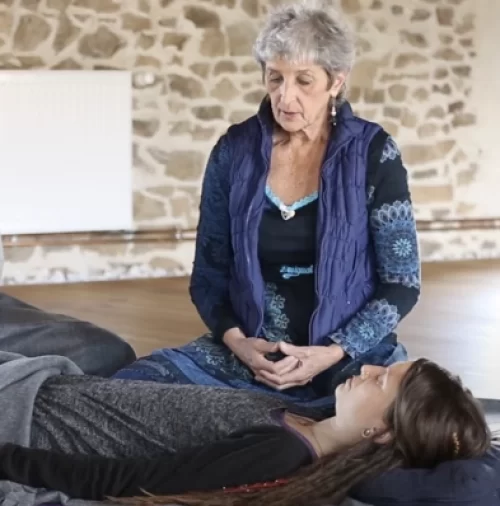CONSCIOUS BREATHING FOR TRAUMA RECOVERY (CBTR)
Free online conscious breathing education that is both simple and effective

The CBTR training has been created by Brigitte Martin Powell and Judee Gee, breath specialists and breathwork trainers based in the UK and in France. Judee and Brigitte are former Presidents of the IBF. At the time of developing this programme they were sitting on the IBF-UN working group committee which develops Conscious Breathing projects in alignment with the United Nations 2030 Agenda for Sustainable Development.
The CBTR programme was originally designed for refugees, migrants and victims of natural disasters as well as health care workers, staff and volunteers of relief organisations.
It has been now extended to include anyone suffering from trauma, anxiety, burnout and depression.
The goal of the CBTR programme is to provide free online conscious breathing education that is both simple and effective through:
- Giving practical instructions for developing an awareness of current breathing habits
- Teaching specific breathing exercises to recalibrate the autonomic nervous system
What is coherent breathing
Coherent Breathing and the Autonomic Nervous System
Un composant majeur du système de réponse au stress est le système nerveux autonome, qui gère les fonctions automatiques du corps, y compris les systèmes cardiovasculaire, respiratoire, digestif, hormonal, glandulaire et immunitaire. Le système nerveux autonome a deux branches principales: le système nerveux sympathique – le système de combat ou de vol – et le système nerveux parasympathique – le reste et digérer ou nourrir et se reproduire– système.
Idéalement, les deux systèmes sont tenus d’intervenir pour des actions spécifiques à travers notre vie quotidienne, mais à long terme un équilibre entre les deux est nécessaire. Un corps qui est constamment sous le stress mental, physique ou émotionnel (système sympathique) sans temps pour se reposer, intégrer et reconstituer (système parasympathique), ne sera pas en mesure de fonctionner de manière optimale et en subira les conséquences.

There is one automatic function of the body that can be voluntarily controlled through our breath and that is the respiratory system! Les techniques de respiration consciente offrent un accès facile au réseau de communication autonome et en changeant nos habitudes respiratoires, nous envoyons des messages spécifiques au cerveau qui ont des effets puissants sur nos pensées, nos émotions et nos comportements. Par exemple, lorsque nous nous sentons anxieux, quelques minutes de respiration cohérente peuvent calmer notre esprit inquiet et favoriser une prise de décision plus rationnelle – plutôt qu’impulsive.
Pratique de respiration cohérente : Respirer au rythme de 5 respirations par minute est le rythme respiratoire optimal pour rééquilibrer le corps et accéder à un état intérieur de relaxation qui est à la fois paisible et reposant. Cinq respirations par minute correspond à respirer pendant 6 secondes et à l’extérieur pendant 6 secondes, reliant le souffle et l’essoufflement d’une manière détendue.
Comment pratiquer: Commencez progressivement, en respirant consciemment et de façon détendue pendant 3 secondes et 3 secondes, jusqu’à ce qu’il se sente à l’aise. Ensuite, passez à la respiration pendant 4 secondes et 4 secondes et progressez à votre propre rythme jusqu’à 6 secondes et 6 secondes. Les gens plus grands pourraient vouloir respirer plus lentement.
Où pratiquer: Commencez par trouver un endroit calme où vous pouvez être tranquille pendant plusieurs minutes. Des conditions de lumière douce ou l’obscurité vous aideront à vous détendre. Ayez une couverture légère à portée de main pour être sûr de rester au chaud. Asseyez-vous ou allongez-vous dans une position confortable et commencez votre pratique. Une fois que vous vous sentez à l’aise avec la pratique, vous pouvez l’appliquer dans un large éventail de situations (assis, marcher…).
Quand pratiquer : Trois fois par jour pendant cinq minutes (365) est un excellent début, et si vous pouvez appliquer la pratique quotidiennement pendant quelques semaines, vous récolterez le plus d’avantages. Même une minute de respiration cohérente aidera à rééquilibrer votre système nerveux. Stephen Elliot suggère 20 min par jour pendant une période de 21 jours afin de recalibrer le système nerveux et d’installer le réflexe respiratoire cohérent comme une pratique par défaut.
The CBTR training has been created by Brigitte Martin Powell and Judee Gee, breath specialists and breathwork trainers based in the UK and in France. Judee and Brigitte are former Presidents of the IBF. At the time of developing this programme they were sitting on the IBF-UN working group committee which develops Conscious Breathing projects in alignment with the United Nations 2030 Agenda for Sustainable Development.
CBTR VIDEOS
Watch the trailer:
Watch the Presentation:
Watch the Demonstration:
Credits
Thanks to the IBF Development Fund for funding the development of the CBTR training programme in Athens, Greece.
THE CBTR MANUALS
THE IBF BREATHING APP
This free app is the perfect tool to practice the CBTR Program – and much more.
It is now available for free for iPhones on the Apple Store and for Androids on the Google Play Store. The name of the app is IBF Breathing App.
If you want to get more detailed information about the IBF Breathing app, click here:

For more information about Coherent Breathing
Keywords for Internet search
Respiration consciente
Holotropique
Coherent Breathing
Stephen Elliott
Sympathetic and Parasympathetic Nervous System
Heart Rate Variability (HRV)
démenti
This presentation is designed to provide helpful guidance for recovering from trauma and reinforcing natural resiliency, but should not be used to diagnose or treat any health or medical conditions requiring medical supervision.
The publisher and authors are not liable for any consequences from the application by any person using the information provided in the presentation. Even though conscious breathing is simple and safe, some may find this method challenging, and are encouraged to consult a conscious breathing specialist in order to progress in the practice.